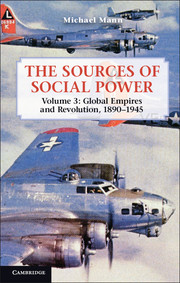Book contents
- Frontmatter
- Contents
- Preface
- 1 Introduction
- 2 Globalization imperially fractured
- 3 America and its empire in the Progressive Era, 1890–1930
- 4 Asian empires
- 5 Half-global crisis
- 6 Explaining revolutions
- 7 A half-global crisis
- 8 The new deal
- 9 The development of social citizenship in capitalist democracies
- 10 The Fascist alternative, 1918–1945
- 11 The Soviet alternative, 1918–1945
- 12 Japanese imperialism, 1930–1945
- 13 Explaining the Chinese revolution
- 14 The last interimperial war, 1939–1945
- 15 Conclusion
- Bibliography
- Index
3 - America and its empire in the Progressive Era, 1890–1930
Published online by Cambridge University Press: 05 November 2012
- Frontmatter
- Contents
- Preface
- 1 Introduction
- 2 Globalization imperially fractured
- 3 America and its empire in the Progressive Era, 1890–1930
- 4 Asian empires
- 5 Half-global crisis
- 6 Explaining revolutions
- 7 A half-global crisis
- 8 The new deal
- 9 The development of social citizenship in capitalist democracies
- 10 The Fascist alternative, 1918–1945
- 11 The Soviet alternative, 1918–1945
- 12 Japanese imperialism, 1930–1945
- 13 Explaining the Chinese revolution
- 14 The last interimperial war, 1939–1945
- 15 Conclusion
- Bibliography
- Index
Summary
When the United States came to dominate the world after World War II, its institutions became of global significance, so I pay a great deal of attention in this volume to them. The United States today is the most capitalistic of powers, and the only remaining imperial power, and both have major global reverberations. The most common trope deployed to explain this is American exceptionalism, the claim that the United States has long been utterly different from any other country. We shall see in later chapters that this has been greatly exaggerated, except in one respect – race. Overall, however, the trope works better today than it did in the past. In this chapter, I examine the United States both at home and abroad, at home dealing with a distinctive progressive reform movement even when it was joining the Western imperialist club – a very mixed story.
Americans do not like being called imperialist. Did not the Founding Fathers and the Constitution light the lamp of liberty for the world? Did not the United States lead the fight against fascism, communism, and other empires? The United States is said to have inspired freedom, not empire, its involvements abroad helping other peoples attain liberty, too – “Wilsonian interventionism,” not imperialism. Americans are in denial about empire because the United States began by conquering an empire within its own continent, then within its own hemisphere, and finally acquired near-global domination. After the continental phase, three outward imperial surges occurred, one after 1898, a second after 1945, and a third, failed one, came at the turn of the twenty-first century. In this chapter, I focus on the 1898 surge. I exclude American involvement in East Asia, which will come in chapters focussed on China and Japan. American involvement in World War I is discussed in Chapter 5.
- Type
- Chapter
- Information
- The Sources of Social Power , pp. 58 - 99Publisher: Cambridge University PressPrint publication year: 2012



